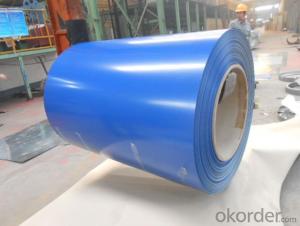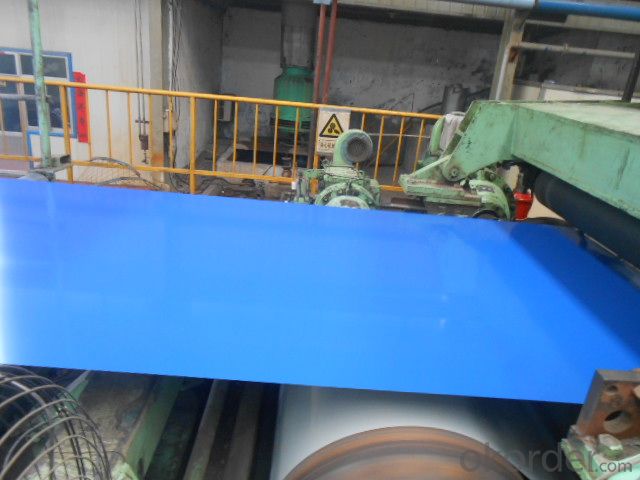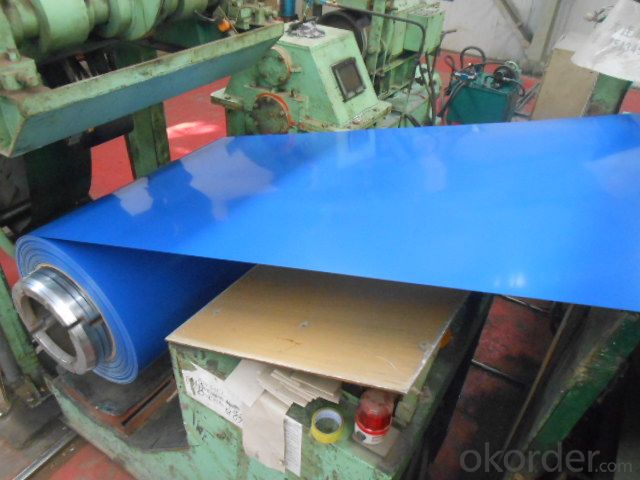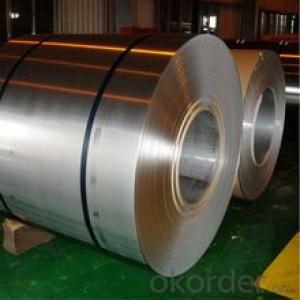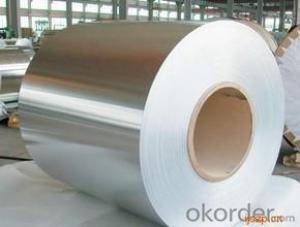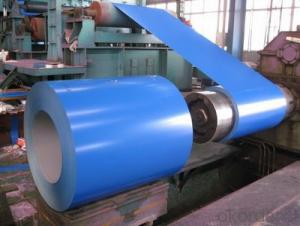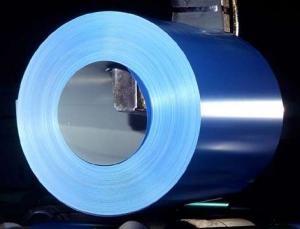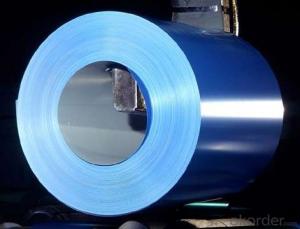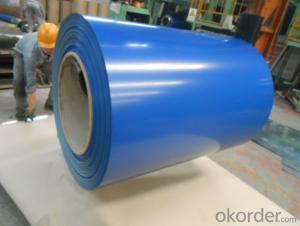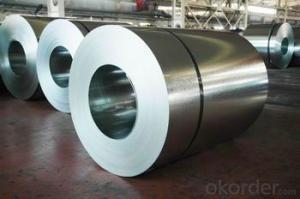Color Coated Galvanized Steel Coil PPGI in Blue
- Loading Port:
- Shanghai
- Payment Terms:
- TT OR LC
- Min Order Qty:
- 50 m.t.
- Supply Capability:
- 10000 m.t./month
OKorder Service Pledge
OKorder Financial Service
You Might Also Like
1.Structure of Pre-painted Galvanized/Aluzinc Steel Coil Description
With GI (aluzinc) as base metal, after pretreatment (degrease and chemical treatment) and liquid dope with several layers of color, then after firing and cooling, finally the plate steel is called pre-painted galvanized (aluzinc) steel. Pre-painted galvanized steel is good capable of decoration, molding, corrosion resistance. It generally displays workability, durability and weather resistance.
2.Main Features of the Pre-painted Galvanized/Aluzinc Steel Coil
• Excellent corrosion resistance
• Excellent weather resistance
• Capability of decoration, molding, corrosion resistance
• Workability, durability
• Excellent heat resistance performance
• High strength
• Good formability
• Good visual effect
3.Pre-painted Galvanized/Aluzinc Steel Coil Images
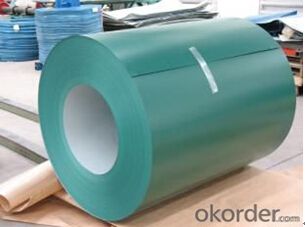
4.Pre-painted Galvanized/Aluzinc Steel Coil Specification
Quality standar: JIS G3312 CGCC & CGLCC
Hardness of P: Both soft and hard quality are available
Surface finish: with or without protect film
Thickness : 0.14-1.20 mm
Width : 914mm, 1000mm, 1220mm and 1250mm, thickness 600-1250mm is available
Finish by coil or sheet: Both sheet and coil are available
8Zinc coating: 60-275G/M2, both sides
Paint thickness for top side : 5 micron primer + (10-20) microns modified polyester, green color.
Paint thickness for back side: (5-10) microns Epoxy
Weight per coil: 4-6 tons, also can be upon customer's requirements
Max loading weight in one 20ft container : 25 tons generally
5. FAQ of Pre-painted Galvanized/Aluzinc Steel Coil
We have organized several common questions for our clients,may help you sincerely:
1. What is the minimum order quantity ?
Our MOQ is 50mt for each size. And we will consider to give more discount if you make big order like 1000 tons and more. Further more, the more appropriate payment term your offer the better price we can provide.
2. How long can we receive the product after purchase?
Usually within thirty working days after receiving buyer’s advance payment or LC. We will arrange the factory manufacturing as soon as possible. The cargo readiness usually takes 15-25 days, but the shipment will depend on the vessel situation.
3. How to guarantee the quality of the products?
We have established the international advanced quality management system,every link from raw material to final product we have strict quality test;We resolutely put an end to unqualified products flowing into the market. At the same time, we will provide necessary follow-up service assurance.
- Q: I work the Copper plating line at a custom plating facility in MI.I like to use jumper cables with the jumper cable clamps to help confirm electric current is getting to my parts that I am plating. The acids in the Acid copper is constantly eating the steel and copper clamps. WIll I get a good enough current through stainless steel clamps? I use stainless steel hooks, but our maintenance man thinks that is one of the reasons why I have prblems with my parts turning out. I still think it has to do with the clamps getting eatin up. My question is Is stainless steel as good or reliable enough to run an electrical current to my parts if I am using stainless steel or is it best to use another method to try and get a better connection.Please state your sources or experience with working with electricity. I need to get honest answers and not this is my opinion. We are talking about my making a living so this is important to me so I can bring food home to my table. Thanks for all the help.
- I can only guess. I can't even tell if you are plating some other metal with copper OR if you are plating copper with some other metal. you state that you use the copper clamps only to confirm the current, but I don't see how that works. I suspect that the plating current actually goes through these clamps, so conductivity is very important. But, the conductivity of SS is about 1/5th that of copper, so that will definitely have an effect, and not a good one. .
- Q: I don't know why but I'm having a VERY difficult time finding the melting point of 1008 steel.
- 1. okorder 2. Input (melting point 1008 steel) as the search string 3. Check the links; the third one showed the answer in an MSDS
- Q: How are steel coils used in the production of electrical wiring?
- Steel coils are used in the production of electrical wiring as a core material for the conductors. The steel coils are typically shaped into a cylindrical form and coated with an insulating material. This helps in providing structural support to the wiring and also enhances its conductivity and durability.
- Q: Can steel coils be used in architectural applications?
- Yes, steel coils can be used in architectural applications. Steel coils are versatile and can be processed into various shapes and forms to meet the unique design requirements of architectural projects. They can be used in the construction of buildings, bridges, and other structures, as well as in the fabrication of architectural elements such as roofing, cladding, and facades. Steel coils offer several advantages in architectural applications. They are highly durable, strong, and resistant to corrosion, making them suitable for long-lasting and low-maintenance structures. Steel coils can also be customized in terms of thickness, width, and surface finish, allowing architects to achieve their desired aesthetic and functional goals. In addition, steel coils are known for their structural stability and load-bearing capacity, which are crucial factors in architectural designs. Their high strength-to-weight ratio makes them an ideal choice for creating large and open interior spaces, as well as for supporting heavy loads in multi-story buildings. Furthermore, steel coils can be easily fabricated and installed, saving time and labor costs during construction. They can be efficiently formed, cut, and welded to create complex shapes or architectural details. Moreover, steel coils can be pre-fabricated off-site, ensuring precision and quality control, and then assembled on-site, reducing construction time and minimizing disruptions to the surrounding environment. Overall, steel coils offer architects and designers a wide range of possibilities in architectural applications. Whether it is for structural support, aesthetic appeal, or functional requirements, steel coils provide a reliable and versatile material option that can meet the demands of modern architectural projects.
- Q: How are steel coils inspected for coil weight accuracy after processing?
- Steel coils are typically inspected for coil weight accuracy after processing by using weighing scales or load cells. These devices are placed underneath the coil or integrated into the production line to measure the weight accurately. The coil's weight is then compared to the desired weight specified by the customer or industry standards to ensure accuracy.
- Q: What are the common welding techniques used for steel coils?
- The common welding techniques used for steel coils include shielded metal arc welding (SMAW), gas metal arc welding (GMAW), and flux-cored arc welding (FCAW). SMAW, also known as stick welding, is a manual welding process where an electric current is used to create an arc between the welding electrode and the base material. The electrode is coated with a flux material that provides a shielding gas to protect the weld from atmospheric contamination. This technique is versatile and can be used for both thick and thin steel coils. GMAW, commonly referred to as MIG (metal inert gas) welding, is an automated process that uses a continuous wire electrode and a shielding gas to protect the weld area. The electrode is fed through a welding gun, and an electric current creates an arc between the wire and the base material. This technique is fast and efficient, making it suitable for high-volume production of steel coils. FCAW is a variation of GMAW that uses a tubular electrode filled with flux instead of a solid wire. The flux provides a shielding gas and also releases additional fluxing agents to protect the weld from impurities. FCAW is often preferred for welding thicker steel coils as it provides better penetration and higher deposition rates. In addition to these techniques, other welding methods like laser welding and electron beam welding can also be used for specific applications in steel coil manufacturing. These techniques offer precise and high-quality welds but are typically more expensive and require specialized equipment. Overall, the choice of welding technique for steel coils depends on factors such as the thickness of the material, production volume, and specific requirements of the end product.
- Q: Can steel coils be coated with fire-resistant materials?
- Yes, steel coils can be coated with fire-resistant materials.
- Q: How are steel coils used in the manufacturing of railway tracks?
- Steel coils are used in the manufacturing of railway tracks as they are processed into long, continuous lengths of steel rails. These coils are first uncoiled and then passed through a series of machines that shape, cut, and weld them together to form the required lengths and profiles of railway tracks.
- Q: How are steel coils used in the manufacturing of shipbuilding?
- Steel coils are used in shipbuilding for several purposes. They are primarily used to fabricate the hull and structural components of ships. Steel coils are cut, shaped, and welded to form various ship sections, such as the hull plates, bulkheads, and decks. These coils provide the necessary strength, durability, and corrosion resistance required for marine applications. Additionally, steel coils are also used to manufacture other shipbuilding components like piping, machinery, and equipment, ensuring the overall integrity and functionality of the vessel.
- Q: How are steel coils used in the production of telecommunications equipment?
- Steel coils are used in the production of telecommunications equipment for various purposes, such as creating structural components, housing enclosures, and mounting brackets. The steel coils are often shaped, cut, and formed into different parts that provide strength, durability, and support to the equipment. Additionally, steel coils may be used in the manufacturing of antennas, transmission towers, and other infrastructure elements that are crucial for telecommunications networks.
Send your message to us
Color Coated Galvanized Steel Coil PPGI in Blue
- Loading Port:
- Shanghai
- Payment Terms:
- TT OR LC
- Min Order Qty:
- 50 m.t.
- Supply Capability:
- 10000 m.t./month
OKorder Service Pledge
OKorder Financial Service
Similar products
Hot products
Hot Searches
Related keywords
